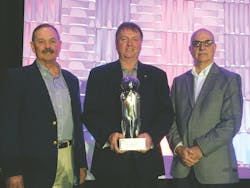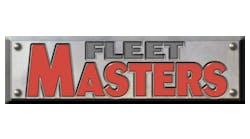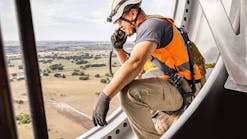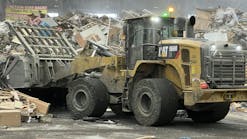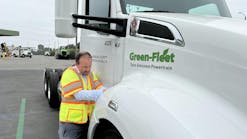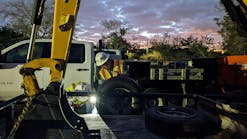Nowhere is this more evident than with Tier 4 emissions.
More on Manatee County
“Between our on-road and off-road equipment, we’ve been dealing with IT4 and full Tier 4 now for years,” says Michael Brennan, CEM, Manatee County fleet manager. “We’ve got some things up our sleeve that we’ve learned—we’re just beginning to get into those things now.”
First came lessons from the county’s on-road fleet, learning about SCR technology and DEF. Unlike some fleet managers, Brennan says nothing in his on-road experiences caused him to delay buying Tier 4-Final iron.
Interestingly, Brennan delayed a major on-road vehicle purchase specifically to time it with the next, more stringent set of regulations, rather than avoid the new technology with a pre-buy. This move gave him insight into what was coming in the heavy equipment arena with fuel economy.
“Tier 4 is identical to the on-road 2010 emissions, and we actually held off buying some medium and heavy trucks waiting for Tier 4,” Brennan says. “Back when the on-road emissions were coming on, we knew that fuel economy actually took a hit with the 2007 regs, equal to IT4 on the equipment side; it went down a little bit. In the 2010 regulations, or Final Tier 4, fuel economy got much better, so we waited for the 2010, or the Final Tier 4, emissions.”
Brennan says the county did not put off purchases on the heavy equipment side nor did it accelerate equipment replacement, sticking to a replacement schedule as planned.
The county has Tier 4-Final large tractors and several job site pieces of equipment such as skid steers and mini excavators, and more than 200 on-road diesels. They’ve essentially been SCR laboratories for Manatee.
“With Tier 4-Final, it’s not ‘forget it, you don’t need to worry about it, pour in some DEF, and let it go’—there is maintenance you’re going to have to do,” Brennan says. “You need to develop a PM program or update your PM program to specifically address the Tier 4 emissions and equipment associated with it.”
Running regens
Manatee County learned a lot about Final Tier 4 through Tier 4-Interim-period DPF technology. “That forced us to take a look at our PM program based on our utilization and develop practices into our PM program so that we could maintain serviceability on the units and be proactive and predictive on when a major service was going to be needed,” Brennan says.
“As a result, and because we’re a municipal county government, not a long-haul or high-hour-operation user, when a unit comes in for PM, either by hours or by mileage, off-road or on-road, before it leaves the shop, we force a regen on the exhaust,” he says. “We go out and burn that exhaust, so that system is not going to fail in the field between PM intervals.”
The forced regens have made sense based on operating patterns and applications, and Brennan believes they have avoided problems.
“We have a lot of service-type vehicles; we’re dealing with infrastructure, water, sewer, traffic signals, road maintenance, all these types of things, so our vehicles and equipment on job sites can have a lot of idle time,” Brennan says. “Our field-service trucks...may be running a crane, or they may be running ancillary equipment where that engine is running at a high-idle situation—they’re really not getting the mileage, but they’re getting the engine hours on it. Same thing with our IT4 and Tier 4-Final equipment. It’s out there on the job site, there’s an operator in it, he lowers a pump down into the hole, or a piece of pipe, and then he waits for the guys to get it hooked up, and then he goes to work again. We experience a lot of that kind of necessary idle time where the operator is waiting for a task to be done before he re-engages.”
With the focus on prevention, operators rarely have to worry about the technology, Brennan says. “Very rarely do we get a call from an operator or a supervisor out in the field saying he’s got a check engine light or an emission warning saying that he’s got to do something with it in the next 50 hours or he’s going to shut the machine down.”
Do-it-yourself DPF cleaning
Similar to its actions on regeneration, the county does not wait for OEMs’ recommended intervals on DPF maintenance or replacement. Several years ago, it bought DPF cleaning equipment to do its own filter cleaning.
“We’re able to take the DPFs off the units on a major PM, we’ll put them in the system, we’ll heat it up to temperature, we have a separate cooker on it, and it brings the temperature up to 600 degrees. Then we’ll move it over into the cleaning apparatus and clean it,” Brennan says.
The DPFs are cleaned at about 75 percent of their life expectancy. “We clean it before failure, and we will extend the life of that DPF unit about half again of what the manufacturer says it’s going to go,” he says.
“So if the manufacturer says it’s going to go 125,000 miles or the equivalent in hours, we’re going to pull that unit out somewhere between 75,000 and 90,000 miles, or 7,500 hours, and we’re going to clean it. We make sure we get all the ash out of it, all the debris out of it, and we reinstall it. We’ll go right back to the same program before going into engine rebuild or a major overhaul where you would go ahead and replace it anyway,” Brennan says.
The cleaning system cost the county about $22,000, but pricing can run anywhere from $15,000 to over $100,000, depending on the volume and the actual size of units being cleaned, according to Brennan. It’s an investment he’s convinced pays the county back.
“DPFs are expensive, and if you can clean them, not only are you extending the life of the DPF and your exhaust system, but you’re eliminating the potential downtime that could be caused by a DPF failure,” he says.
SCR system maintenance
“Through that DPF process, we’ve learned and planned ahead, adapting the same type of program for Tier 4-Final SCR technology. Now, you don’t need to deal with it on every PM, like we do in forcing our regens, but at certain service intervals we do some DEF testing, and then we have some scheduled service intervals for the Final Tier 4 equipment,” Brennan says.
“The diesel exhaust fluid is over 65 percent water, so it evaporates. And no matter how good your operators are in keeping those onboard tanks sealed up and clean, you’re going to get crystallization in the onboard tanks and it’s microscopic,” Brennan says.
That crystallization can lead to insidious damage.
“What happens over time is that it starts to etch and expand the jets in the injectors that are in the exhaust stream,” Brennan explains. “You’re going to get to a point where it will start actually dripping urea into the system instead of spraying it and atomizing it. So you’re going to get a build-up of crystalized DEF in the exhaust system. We’ve learned that from our on-road experience, so we’ve incorporated into our PM program specific intervals where we will change the filters in the urea tanks.
“We will drain it out, clean the tanks, and also at certain other intervals we’ll go in and replace the injector in the upstream system. In the meantime, we test the urea for specific gravity to make sure we’ve got good quality product not only in our bulk tanks and our totes around the shop, but also in the equipment itself,” Brennan says.
Brennan does so many things in a preventive mode and before manufacturers’ recommendations that it almost sounds as if he doesn’t trust the OEM guidelines, and that he’s skeptical of marketing points repeating that DPFs are cleaned automatically with transparency to the process and no operator effort. Or, that SCR systems are proven and trouble-free.
“In the perfect world, yes, these systems are all probably going to do exactly what the OEM says they are going to do; however you can’t control what goes on out there in the field, especially when units are 20, 50, or 500 miles away from you,” he says.
“Everything’s a little bit different, depending on where it goes and what it does,” he says. “So you also have to arm your operators with the knowledge of what’s supposed to be done, you have to give them a little bit of training so they know what to do if something happens, and you have to tell them that if you see any unusual things happening, just pick up the phone and call the shop.”
Brennan hopes the county’s experience with Tier 4 can help other fleets. “Your maintenance is going to go up [with Tier 4], there’s no doubt; it’s another system on the equipment. That system is going to require attention, but it’s a lot cheaper to do that preventive, predictive maintenance than it is to do that repair out in the field or on the job site when you have to shut down that job. You’re going to need to build it into your PM program, because this is something you can’t ignore. And anybody who is going to try to skimp on it or not address it right up front, they’re going to find later on down the road that a problem is going to be very expensive to correct. It’s ‘pay me now or pay me later;’ it’s going to happen.”
